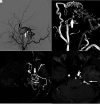Endovascular Management of Intracranial Dural AVFs: Principles
- PMID: 34674996
- PMCID: PMC8985683
- DOI: 10.3174/ajnr.A7304
Endovascular Management of Intracranial Dural AVFs: Principles
Abstract
Intracranial dural AVFs are abnormal communications between arteries that supply the dura mater and draining cortical veins or venous sinuses. They are believed to form as a response to venous insults such as thrombosis, trauma, or infection. Classification and management are dependent on the presence of drainage/reflux into cortical veins because such drainage markedly elevates the risk of hemorrhage or venous congestion, resulting in neurologic deficits. AVFs with tolerable symptoms and benign drainage patterns can be managed conservatively. Intolerable symptoms, presentation with hemorrhage/neurologic deficits, or aggressive drainage patterns are indications for intervention. Treatment options include microsurgical disconnection, endovascular transarterial embolization, transvenous embolization, or a combination. This is the first in a series of 3 articles on endovascular management of intracranial dural AVFs, in which we outline the principles and outcomes of endovascular treatment.
© 2022 by American Journal of Neuroradiology.
Figures



Similar articles
-
Endovascular management of intracranial dural arteriovenous fistulas.Handb Clin Neurol. 2017;143:117-123. doi: 10.1016/B978-0-444-63640-9.00011-4. Handb Clin Neurol. 2017. PMID: 28552133 Review.
-
Endovascular Management of Intracranial Dural AVFs: Transvenous Approach.AJNR Am J Neuroradiol. 2022 Apr;43(4):510-516. doi: 10.3174/ajnr.A7300. Epub 2021 Oct 14. AJNR Am J Neuroradiol. 2022. PMID: 34649915 Free PMC article. Review.
-
Advances in surgical approaches to dural fistulas.Neurosurgery. 2014 Feb;74 Suppl 1:S32-41. doi: 10.1227/NEU.0000000000000228. Neurosurgery. 2014. PMID: 24402490 Review.
-
Three-dimensional angioarchitecture of spinal dural arteriovenous fistulas, with special reference to the intradural retrograde venous drainage system.J Neurosurg Spine. 2013 Apr;18(4):398-408. doi: 10.3171/2013.1.SPINE12305. Epub 2013 Feb 22. J Neurosurg Spine. 2013. PMID: 23432326
-
Combined surgical and endovascular treatment of high-risk intracranial dural arteriovenous fistulas.J Clin Neurosci. 2002 May;9 Suppl 1:11-5. J Clin Neurosci. 2002. PMID: 23570148
Cited by
-
Acquired progressive torcular dural arteriovenous fistula after subtotal resection of peritorcular meningioma.BMJ Case Rep. 2024 Nov 28;17(11):e260637. doi: 10.1136/bcr-2024-260637. BMJ Case Rep. 2024. PMID: 39613419 Free PMC article.
-
[Cerebral dural arteriovenous fistulas].Radiologie (Heidelb). 2022 Aug;62(8):659-665. doi: 10.1007/s00117-022-01036-0. Epub 2022 Jun 23. Radiologie (Heidelb). 2022. PMID: 35736997 Review. German.
-
In-out-in technique for petrosal sinus dural arteriovenous fistula obliteration: How I Do It.Acta Neurochir (Wien). 2023 Dec;165(12):3793-3798. doi: 10.1007/s00701-023-05822-0. Epub 2023 Oct 2. Acta Neurochir (Wien). 2023. PMID: 37779179
-
Overview of multimodal MRI of intracranial Dural arteriovenous fistulas.J Interv Med. 2022 Nov 28;5(4):173-179. doi: 10.1016/j.jimed.2022.04.004. eCollection 2022 Nov. J Interv Med. 2022. PMID: 36532312 Free PMC article.
-
Quest for the optimal venous access in a complex skull base dural fistula: Case illustrations and principles.Interv Neuroradiol. 2025 Apr;31(2):281-286. doi: 10.1177/15910199251316407. Epub 2025 Feb 3. Interv Neuroradiol. 2025. PMID: 39901568 Free PMC article.
References
Publication types
MeSH terms
LinkOut - more resources
Full Text Sources
